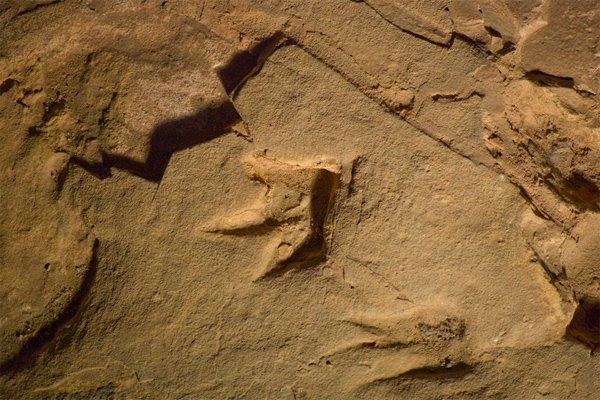Famous dinosaur tracks not from stampede

FOR OVER 30 YEARS, Lark Quarry in central-western Queensland has been regarded as the world’s only evidence of a dinosaur stampede. This is all about to change, however, due to a recent study which suggests that the tracks were made by swimming and wading dinosaurs, rather than those running on land.
Anthony Romilio, a palaeontologist from the University of Queensland who led the study on the 95- to 98-million-year-old tracks, says they were preserved in river sediments when the area was part of an expansive forested floodplain.
Prehistoric prints left by water-loving dinosaurs
“Many of the tracks are nothing more than elongated grooves, and probably formed when the claws of swimming dinosaurs scratched the river bottom,” says Anthony. “Some of the more unusual tracks include ‘tippy-toe’ traces – this is where fully buoyed dinosaurs made deep, near vertical scratch marks with their toes as they propelled themselves through the water.”
“It’s difficult to see how tracks such as these could have been made by running or walking animals,” he adds. “If this was the case, we would expect to see a much flatter impression of the foot preserved in the sediment.”
Anthony says some of the larger tracks are much more consistent with walking animals, suggesting that they may have been left by dinosaurs wading through shallow water.
The study, published this week in the Journal of Vertebrate Palaeontology, found that the river in question may have been a preferred travel route for the herbivorous bipedal dinosaurs, which ranged in size from emu- to chicken-sized animals.
One of the most complex dinosaur track sites in the world
Lark Quarry is one of the most complex dinosaur track sites in the world, with a very high number of footprints. Previous research at the site identified, among others, the tracks of two types of smaller dinosaur: the long-toed tracks of Skartopus australis, and the shorter-toed impressions of Wintopus latomorum.
However, 3D analysis has allowed for a new understanding of the larger sequence of tracks at the site. “3D profiles of Skartopus tracks reveal that they were made by a short-toed [dinosaur] dragging its toes through the sediment, thereby elongating the tracks,” says Anthony.
Previous research by Anthony and his supervisor Dr Steve Salisbury also suggested that the larger tracks were made by a herbivorous dinosaur rather than a large carnivorous theropod, as previously thought.
“Taken together, these findings strongly suggest Lark Quarry does not represent a ‘dinosaur stampede’,” says Anthony.
Steve Salisbury says regardless of how it is interpreted, the new findings take nothing away from the importance of the site. “Lark Quarry is, and will always remain, one of Australia’s most important dinosaur track sites,” he says.

These prints were made by a chicken-sized ornithopod dinosaur. The high density of these tracks – there are 3-4000 of them exposed at the site – combined with the range of variation that they exhibit, make Lark Quarry one of the most important dinosaur track sites in Australia. (Credit: Dr Steve Salisbury)
RELATED STORIES




